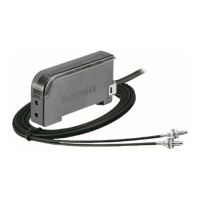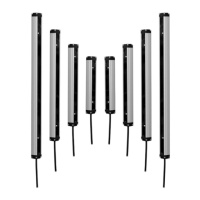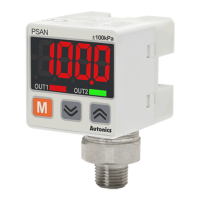D-56
CR Series
Electric capacitive type proximity sensor
Model
CR18-8DN
CR18-3DP
CR18-8DN2
CR30-15DN
CR30-15DP
CR30-15DN2
CR18-8AO
CR18-8AC
CR30-15AO
CR30-15AC
Sensing distance 8mm 15mm
8mm
15mm
Hysteresis Max. 20% of sensing distance
Standard sensing target 50×50×1mm (Iron)
Sensing distance 0 to 5.6mm 0 to 10.5mm 0 to 5.6mm 0 to 10.5mm
Power supply
(Operating voltage)
12- 24VDC
(10 -30VDC)
100-240VAC 50/60Hz
(85-264VAC)
Current consumption Max. 15mA
-
Leakage current
-
Max. 2.2mA
Response frequency
※
1
50Hz 20Hz
Residual voltage Max. 1.5V Max. 20V
Affection by Temp.
Max. ±10% for sensing distance at ambient temperature 20℃
Control output Max. 200mA 5 to 200mA
Insulation resistance Min. 50MΩ (at 500VDC megger)
Dielectric strength 1,500VAC 50/60Hz for 1minute
Vibration 1mm amplitude at frequency of 10 to 55Hz (for 1 min) in each of X, Y
, Z directions for 2 hours
Shock 500m/s² (approx. 50G) in each of X, Y, Z directions for 3 times
Indicator Operation indicator: Red LED
Environ-
ment
Ambient temperature -25 to 70
℃
, storage: -30 to 80
℃
Ambient humidity 35 to 95%RH, storage: 35 to 95%RH
Protection circuit Reverse polarity protection, Serge protection Serge protection circuit
Protection structure IP66 (IEC standard) IP65 (IEC standard) IP66 (IEC standard) IP65 (IEC standard)
Cable
Ø4mm, 3-wire, 2m Ø5mm, 3-wire, 2m Ø4mm, 2-wire, 2m Ø5mm, 2-wire, 2m
(AWG22, Core diameter: 0.08mm, Number of cores: 60, Insulator out diameter: Ø1.25mm)
Material
CR18 - Case/Nut: PA6, Standard cable (Black): Polyvinyl chloride (PVC)
CR30 - Case/Nut: Nickel plated Brass, Washer: Nickel plated Iron, Sensing surface: PBT,
Standard cable (Black): Polyvinyl chloride (PVC)
Weight
※
2
Approx. 88g
(approx. 76g)
Approx. 243g
(approx. 206g)
Approx. 82g
(approx. 70g)
Approx. 237g
(approx. 200g)
Features
● Sensing of iron, metal, plastic, water, stone, wood etc.
● Long life cycle and high reliability
● DC type: Built-in surge protection circuit, reverse polarity
protection circuit
AC type: Built-in surge protection circuit
● Easy to adjust of the sensing distance with sensitivity
adjuster
● Red LED operation indicator
● Easy to control of level and position
Specifications
Type
※
1: The response frequency is the average value. The standard sensing target is used and the width is set as 2 times of the standard
sensing target, 1/2 of the sensing distance for the distance.
※
2: The weight includes packaging. The weight in parentheses in for unit only.
※
Environment resistance is rated at no freezing or condensation.
Appearances Model
M18
CR18-8DN
CR18-8DP
CR18-8DN2
※
M30
CR30-15DN
CR30-15DP
CR30-15DM2
※
Appearances Model
M18
CR18-8AO
CR18-8AC
M30
CR30-15AO
CR30-15AC
DC 3-wire type AC 2-wire type
※
mark can be customized.
Please read “Caution for your safety” in operation
manual before using.












